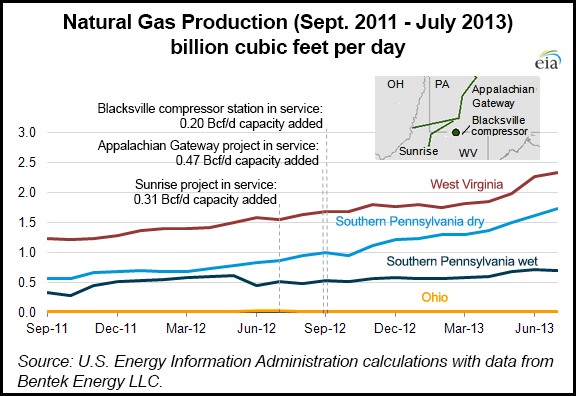NGI The Weekly Gas Market Report
NGI Archives | NGI All News Access
New Infrastructure Said Boosting Northeast Output
ew pipeline and compressor infrastructure has helped boost dry gas production in West Virginia and neighboring southern Pennsylvania counties since early 2012 — in the heart of the Marcellus Shale — with more growth still expected to come in the region despite strategic shifts by oil and gas companies to more liquids-rich targets, the U.S. Energy Information Administration (EIA) said.

The agency took note of three projects from July to September 2012 that combined expanded production capacity by nearly 1 Bcf/d, including two by EQT Corp. subsidiary Equitrans LP. It placed the Sunrise Project into service in July 2012, providing five interconnections and 0.31 Bcf/d of capacity from Wetzel County, WV, to Greene County, PA (see NGI, July 22; July 23, 2012) Equitrans also placed into service last September the 0.20 Bcf/d Blacksville Compressoin Monongalia County, WV. Also contributing to new output is Dominion Transmission Inc.’s Appalachian Gateway Project, in service last September and providing 0.47 Bcf/d of capacity and an interconnect with Texas Eastern Transmission (see NGI, Sept. 3, 2012).
According to the EIA, and coinciding with the arrival of the three new projects, gas production in West Virginia increased 51% from 1.55 Bcf/d in mid-July 2012 to 2.34 Bcf/d last month. In the dry region of southern Pennsylvania, average daily production during the same time frame doubled to 1.73 Bcf/d from 0.86 Bcf/d.
“Although producers have increasingly shifted their attention to more liquids-rich shale gas in the wet gas regions of these states, production in the dry gas regions has benefited from the addition of infrastructure, improving takeaway capacity from their gas fields,” the EIA said. Growth in the region is expected to continue, the agency said, citing Spectra Energy’s Texas Eastern Natrium Lateral Project, a 0.37 Bcf/d capacity pipeline lateral connecting Dominion’s Natrium processing plant near New Martinsville, WV (see NGI, Nov. 5, 2012), to the Texas Eastern mainline near Clarington, WV, with service as early as 4Q2014.
Lou D’Amico, president of the Pennsylvania Independent Oil and Gas Association, told NGI the EIA’s optimism for the region was sound, “to the extent that the infrastructure is available. Anything that’s done to increase pipeline throughput down there will definitely help the dry gas region,” he said (see related story).
West Virginia Oil and Natural Gas Association Executive Director Corky DeMarco added that his state “had a lot of wells that were drilled that could not get into production because of a lack of pipelines, processing facilities, compression — all of the things that make this system work. Those things are being built right now, and will continue to be built, because of this spurred interest in this part of the country.”
© 2024 Natural Gas Intelligence. All rights reserved.
ISSN © 2577-9877 | ISSN © 1532-1266 |

